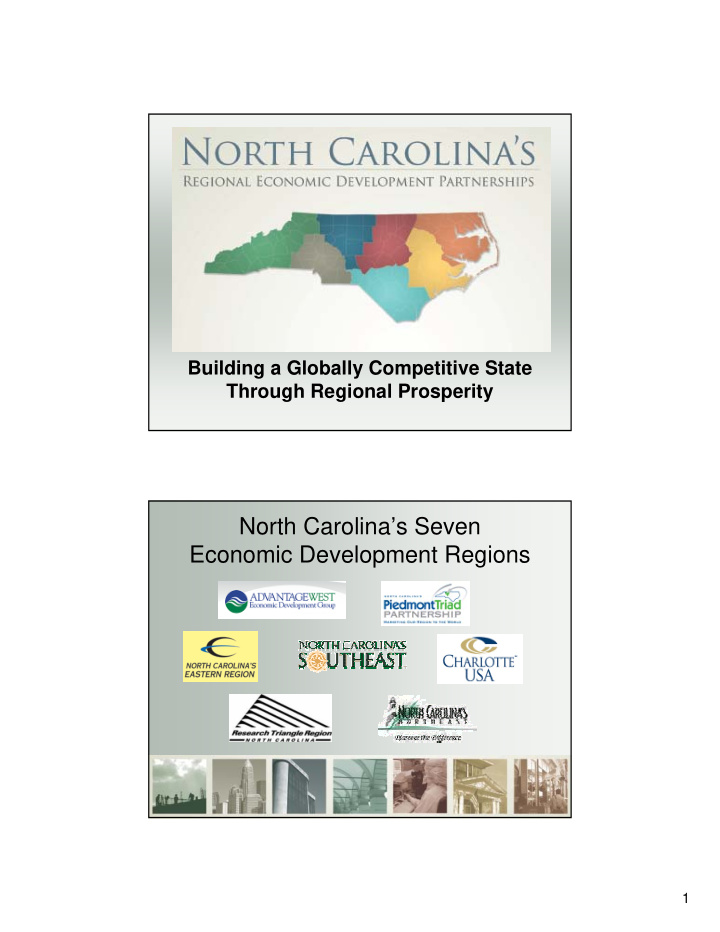



Building a Globally Competitive State Through Regional Prosperity North Carolina’s Seven Economic Development Regions 1
Mission Each partnership customizes its program of work and mission depending upon the assets and needs of the region. Key common elements include: • Serving as a conduit for investment; • Facilitating regional capacity-building; • Conducting strategic regional planning; and most importantly; • Marketing to create jobs and investment. Origins of Regionalism in NC Late ’80s • Business leaders in Greater Charlotte, Piedmont Triad, and the Research Triangle called for collaborative regional strategies to recruit business, attract new investment and create jobs. 2
Origins of Regionalism in NC 1993 • The NC General Assembly saw regionalism’s capacity to create economic opportunities throughout the state. • The General Assembly created regional economic development commissions in four rural regions and recognized the three regional partnerships anchored by urban areas. Uniform Standards 2008: New uniform standards approved by Commerce Secretary Fain and adopted by seven regional partnerships. New standards cover: – Finance and accounting – Procurement and contracting – HR practices – Board governance and ethics 3
Why Regionalism? Simply put, Regionalism works because there are measurable advantages to sharing or leveraging assets, expenses and programs with neighboring communities, organizations and institutions at the regional level. Key Proponents • U.S. Department of Commerce • Office of Economic Development, Kenan Institute of Private Enterprise, University of North Carolina • Harvard Business School • Southern Growth Policies Board • U.S. Department of Labor Employment and Training Administration • Many other countries and states Just to name a few… 4
Consensus on Regional Approach “Regional economies are the building blocks of U.S. competitiveness. The nation’s ability to produce high-value products and services depends on the creation and strengthening of regional clusters of industries that become hubs of innovation.” F. Duane Ackerman, Chairman & CEO, BellSouth Corporation, and Dr. Michael E. Porter, Harvard Business School, in their forward to Clusters of Innovation; Regional Foundations of U. S. Competitiveness, 2001 Consensus on Regional Approach “To stay ahead of global competition, we must identify strategies to further integrate workforce development, economic development, and education at the regional level – where companies, workers, researchers, entrepreneurs and governments come together to create a competitive advantage.” U.S. Department of Labor Employment and Training Administration, February 2006 5
Consensus on Regional Approach “From a national perspective, North Carolina’s legislatively mandated regional approach to economic development is very unique. As a result of the success of having a regional focus, other states have begun to take a closer look.” Jeff Finkle, President & CEO International Economic Development Council, Washington, D.C. Consensus on Regional Approach “The power of regional organizations in no way compromises either community or state roles in economic development. It simply means that communities are better served by aggregating their resources at the regional level, and states are better served by encouraging the delivery of services at the regional level.” The 2005 Report on the Future of the South, The New Architecture of Rural Prosperity , Southern Growth Policies Board 6
Unique Benefits of Regional Partnerships • Leverage state dollars with private, local government and federal funds • Leverage human capital Leverage Volunteer Leaders 7
Economic Development Demonstration Projects The partnerships serve as venues where new programs can be implemented. • Example: Advantage West’s innovative Certified Industrial Site program became a strong product development strategy and was replicated in other regions before being rolled out statewide by the Department of Commerce. Industry-Cluster Targeting • Implemented initially by RTRP, the cluster-based vision for regional economic development brings together and cultivates related employers (industry clusters) as the clearest path to sustainable, high-wage job growth statewide. 8
Clusters of Innovation Research Triangle Regional Partnership Biological Agents and Infectious Disease Logistics Advanced Medical Care Pharmaceuticals Analytical Instruments Agricultural Biotechnology Informatics Pervasive Computing Vehicle Parts Nanoscale Technologies Innovation Led to Statewide Implementation • Cluster studies were incorporated into the Regional Economic Development Vision Plans directed by the General Assembly in 2004. • The cluster development strategies were designed in collaboration with the Department of Commerce, higher education, industry representatives and other local leaders. 9
Results for NC: National Recognition Building a Globally Competitive State Through Regional Prosperity 10
Recommend
More recommend